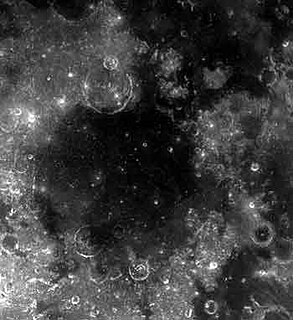
Bradycardia is a condition typically defined wherein an individual has a resting heart rate of under 60 beats per minute (BPM) in adults. Bradycardia typically does not cause symptoms until the rate drops below 50 BPM. When symptomatic, it may cause fatigue, weakness, dizziness, sweating, and at very low rates, fainting.
In mathematics, the Laplace transform is an integral transform named after its inventor Pierre-Simon Laplace. It takes a function of a real variable t to a function of a complex variable s. The transform has many applications in science and engineering.

Paranasal sinuses are a group of four paired air-filled spaces that surround the nasal cavity. The maxillary sinuses are located under the eyes; the frontal sinuses are above the eyes; the ethmoidal sinuses are between the eyes and the sphenoidal sinuses are behind the eyes. The sinuses are named for the facial bones in which they are located.

Mare Humorum is a lunar mare. The impact basin it is located in is 425 kilometers across.

Bianchini is a lunar impact crater that lies along the northern Jura Mountains that ring the Sinus Iridum, in the northwestern part of the near side of the Moon. It was named after Italian astronomer Francesco Bianchini. The impact of this crater near the edge of the Jura Mountains deposited some material into the Sinus Iridum floor.

Le Verrier is a small lunar impact crater located in the northern part of the Mare Imbrium. It was named after French mathematician and astronomer Urbain Le Verrier. To the west is the slightly larger crater Helicon, and farther to the west-northwest lies the mountain-ringed bay Sinus Iridum.

Helicon is a small lunar impact crater that is located on the north part of the Mare Imbrium. The crater was named after 4th century BC Greek astronomer Helicon of Cyzicus, a friend and disciple of Plato. To the northwest is the prominent Sinus Iridum, a mountain-ringed bay on the mare. Just to the east is the slightly smaller crater Le Verrier.

In probability theory and statistics, the Laplace distribution is a continuous probability distribution named after Pierre-Simon Laplace. It is also sometimes called the double exponential distribution, because it can be thought of as two exponential distributions spliced together back-to-back, although the term is also sometimes used to refer to the Gumbel distribution. The difference between two independent identically distributed exponential random variables is governed by a Laplace distribution, as is a Brownian motion evaluated at an exponentially distributed random time. Increments of Laplace motion or a variance gamma process evaluated over the time scale also have a Laplace distribution.

Louville is a lunar impact crater that is located on the western edge of the Sinus Roris, a bay in the northern part of the Oceanus Procellarum. It lies to the northwest of the crater Mairan, on a triangular section of continental terrain to the west of Sinus Iridum and the Mare Imbrium.

Sinus Iridum is a plain of basaltic lava that forms a northwestern extension to the Mare Imbrium on Earth's moon. It is surrounded from the northeast to the southwest by the Montes Jura range. The protruding part of the range at the southwest end is named Promontorium Heraclides, while that at the northeast end is called Promontorium Laplace. This bay and the surrounding mountains is considered one of the most beautiful features on the Moon, and is a favorite among lunar observers.

The Parisi were a British Celtic tribe located somewhere within the present-day East Riding of Yorkshire, in England, known from a single brief reference by Ptolemy in his Geographica of about AD 150. Many writers have connected them with the archaeological Arras culture and some with the more widely known Parisii of Gaul.

Rupes Kelvin is an escarpment near Promontorium Kelvin on the near side of the Moon, at 27.3°S 33.1°W. It is 86 km long. It takes its name from Promontorium Kelvin, which was named after the Irish scientist, physicist and engineer William Thomson, 1st Baron Kelvin.
Pierre-Simon Laplace was a French mathematician and astronomer.

Promontorium Heraclides is a raised mountainous cape situated in Mare Imbrium on the near side of the Moon. Its selenographic coordinates are 40.3° N, 33.2° W and it is 50 km in diameter. It marks the western edge of the bay of Sinus Iridum. Promontorium Heraclides is named after Heraclides Ponticus, a Greek philosopher and astronomer. The Soviet lunar probe Luna 17 landed about 30 km from Promontorium Heraclides on November 17, 1970. The land form is depicted as the face of a woman looking across Sinus Iridum in a 1679 lunar map by Giovanni Domenico Cassini; this depiction, of disputed origin, is known as the "Moon Maiden".

Promontorium Taenarium is a headland on the near side of the Moon. It is located in the eastern end of Mare Nubium. Its length is about 70 km. Its coordinates are 18°39′0″S7°28′24″W.
















